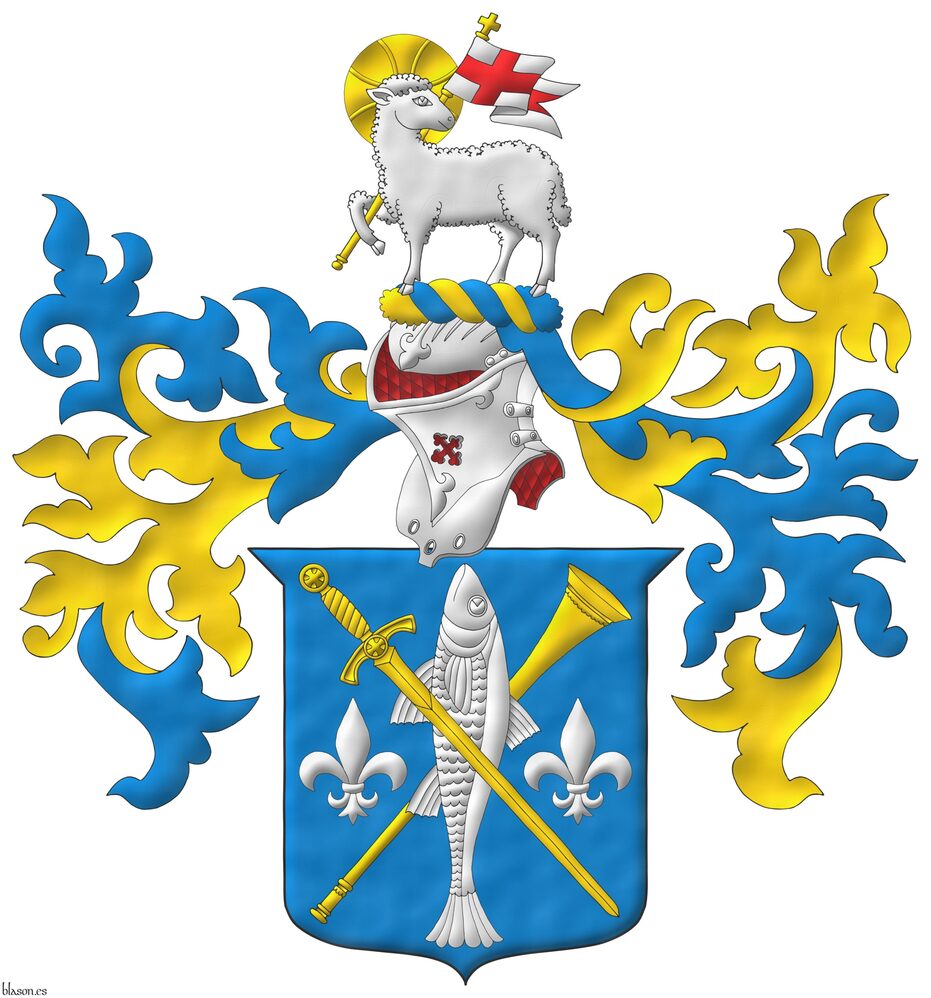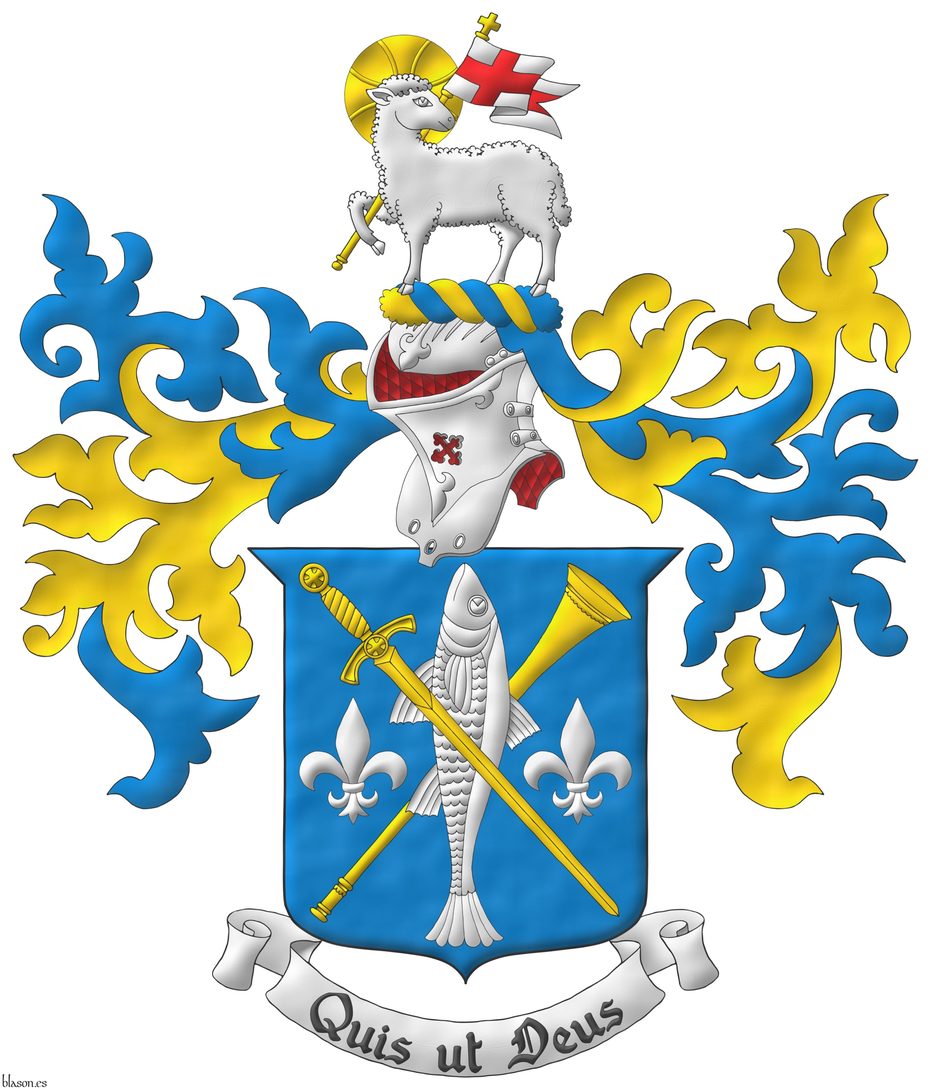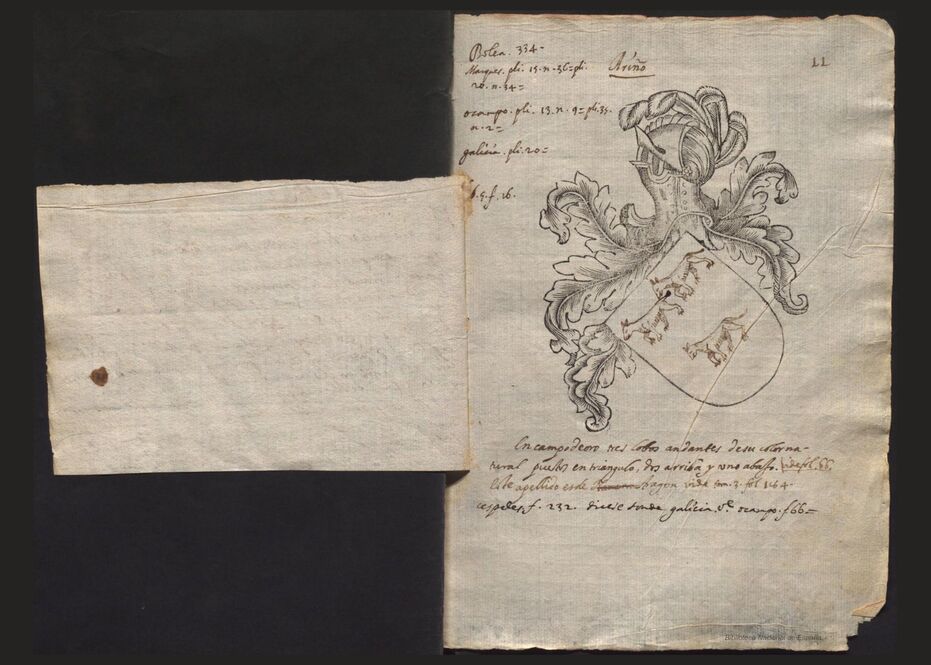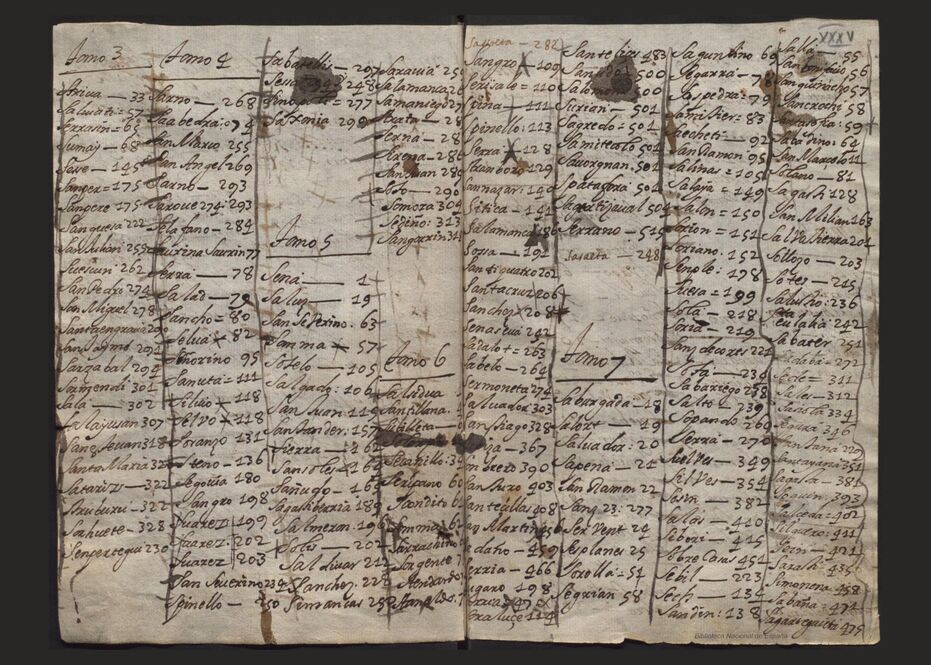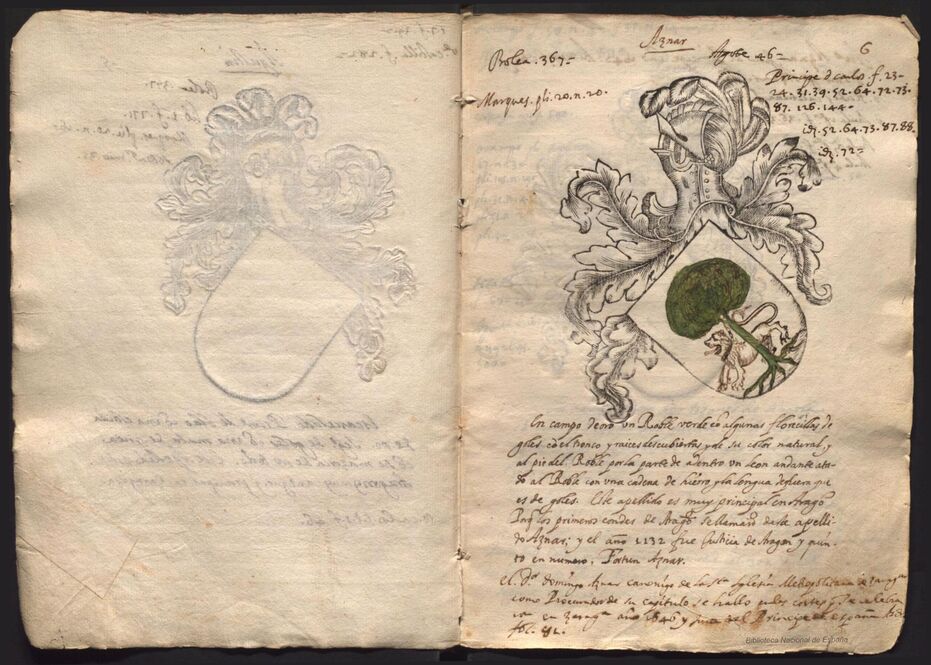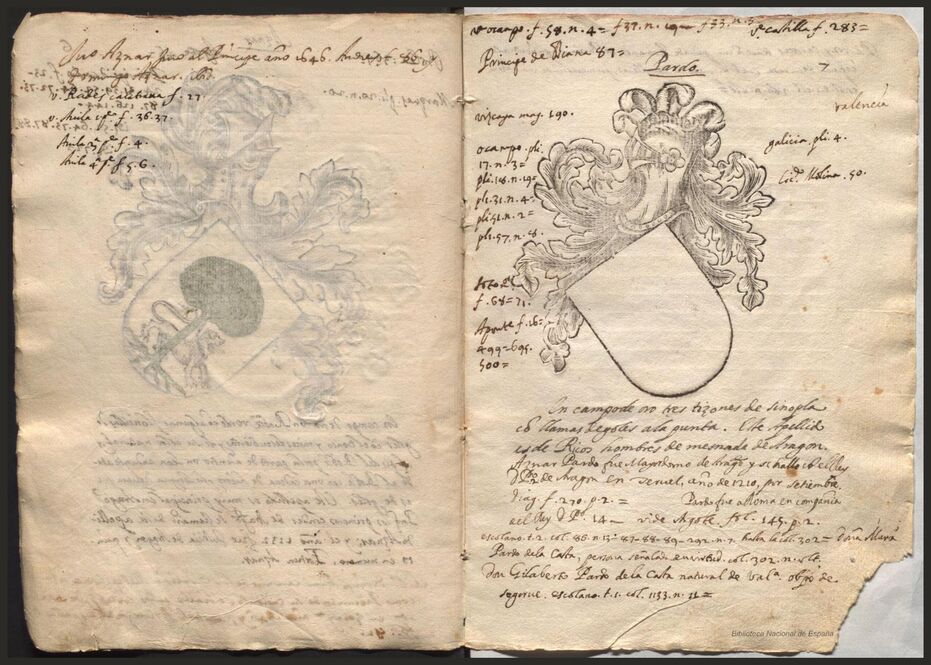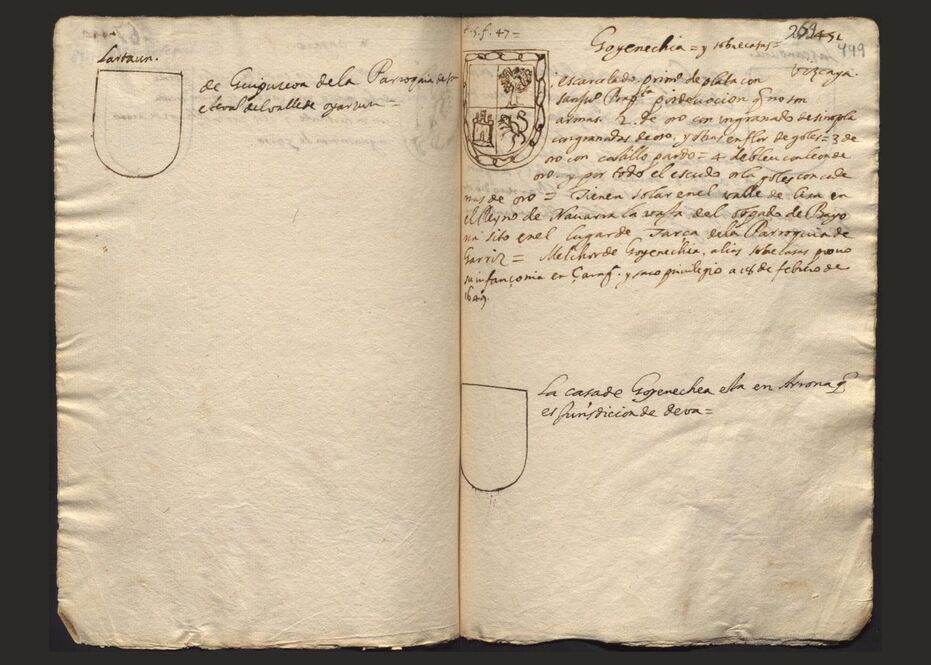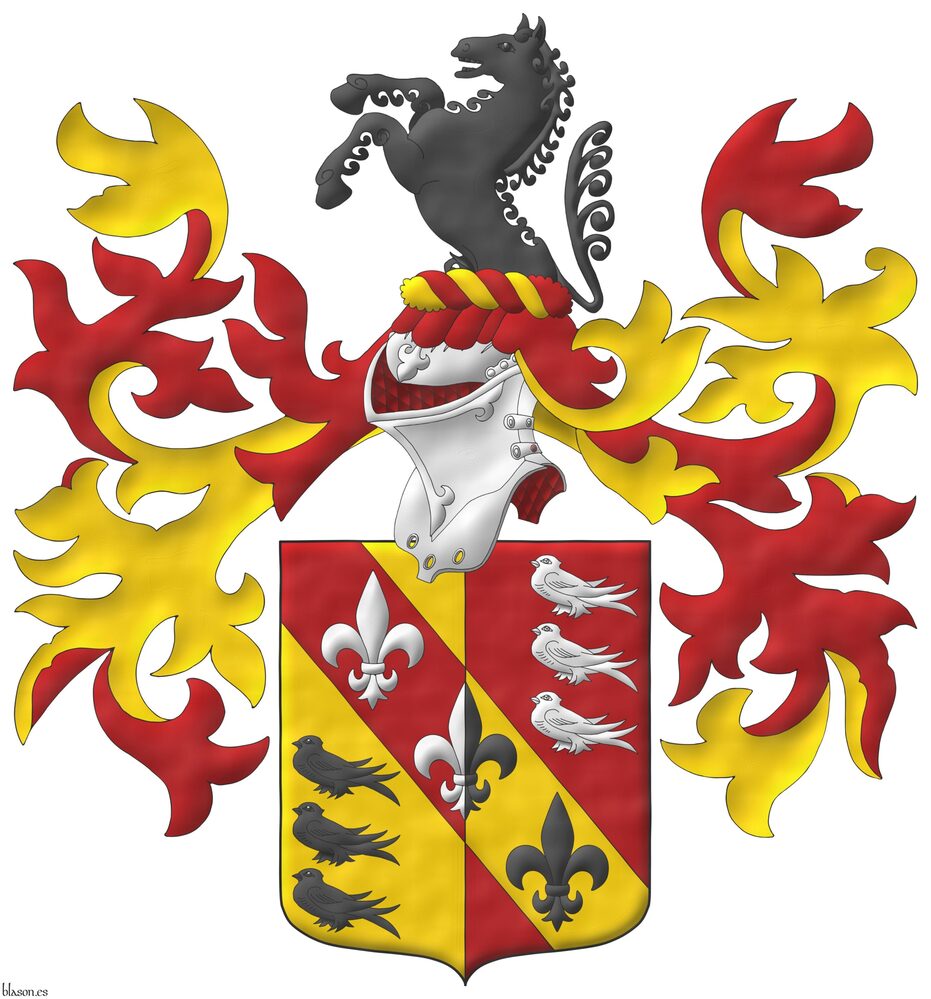
Julio Hector Aspe

Azure, a trumpet bend sinisterwise Or, debruised by a fish haurient Argent, debruised by a sword bendwise point downwards Or, all between two fleurs de lis in fess Argent. Motto: «Quis ut Deus».
Escudo de azur, una trompeta puesta en barra de oro, resaltada de una pez hauriante de plata, resaltado de un espada puesta en banda bajada de oro, todos acompañados de dos flores de lis en faja de plata. Lema: «Quis ut Deus».
Arms devised by me, highlighted with lights and shadows, outlined in Sable, with an ogee triple-pointed external shape and with a watercolor finish.
Blazon keywords: Azure, Argent, Or, Sable, One, Two, Trumpet, Bend sinisterwise, Debruised, Fish, Haurient, Sword, Point downwards, Between, Fleur de lis, In fess and Motto.
Style keywords: Outlined in sable, Illuminated, Ogee Triple-Pointed and Watercolor.
Classification: Personal, Created, Boa and Coat of arms.
Bearer: Aspe, Julio Hector.


Crest and mantling of Julio Hector Aspe
Azure, a trumpet bend sinisterwise Or, debruised by a fish haurient Argent, debruised by a sword bendwise point downwards Or, all between two fleurs de lis in fess Argent. Crest: Upon a helm lined Gules with a wreath Or and Azure, a paschal lamb regardant Argent, nimbed Or, supporting a staff Or, flying a flag Argent charged with a cross Gules. Mantling: Azure doubled Or.
Coat of arms devised by me, highlighted with lights and shadows, outlined in Sable, with an ogee triple-pointed external shape and with a watercolor finishing.
Blazon keywords: Azure, Argent, Or, Gules, One, Two, Trumpet, Bend sinisterwise, Debruised, Fish, Haurient, Sword, Point downwards, Between, Fleur de lis, In fess, Crest and mantling, Crest, Upon (wreath), Helm, Wreath, Paschal lamb, Regardant, Nimbed, Grasping, Shafted, Charged, Cross and Mantling.
Style keywords: Outlined in sable, Illuminated, Ogee Triple-Pointed and Watercolor.
Classification: Personal, Created, Boa, Coat of arms and Flag.
Bearer: Aspe, Julio Hector.


Crest, mantling and motto of Julio Hector Aspe
Azure, a trumpet bend sinisterwise Or, debruised by a fish haurient Argent, debruised by a sword bendwise point downwards Or, all between two fleurs de lis in fess Argent. Crest: Upon a helm lined Gules with a wreath Or and Azure, a paschal lamb regardant Argent, nimbed Or, supporting a staff Or, flying a flag Argent charged with a cross Gules. Mantling: Azure doubled Or. Motto: «Quis ut Deus».
Coat of arms designed by me, illuminated with lights and shadows, outlined in Sable, with an ogee triple-pointed external shape and with a watercolor finishing.
Blazon keywords: Azure, Argent, Or, Gules, Sable, One, Two, Trumpet, Bend sinisterwise, Debruised, Fish, Haurient, Sword, Point downwards, Between, Fleur de lis, In fess, Crest and mantling, Crest, Upon (wreath), Helm, Wreath, Paschal lamb, Regardant, Nimbed, Grasping, Shafted, Charged, Cross, Mantling and Motto.
Style keywords: Outlined in sable, Illuminated, Ogee Triple-Pointed and Watercolor.
Classification: Personal, Created, Boa, Coat of arms and Flag.
Bearer: Aspe, Julio Hector.


![Ver [Salazar y Mendoza, M. de; 1654] en referencias bibliográficas. Libro abierto, hojas de plata, filo de oro, guardas de gules, tapas de sable.](../css/Libro.Bibliografia.png)
Salazar y Mendoza, M. de; 1654
Miguel de Salazar y Mendoza, chronicler and chaplain of honor to Philip IV, «Nobiliario de armas», with contributions from Lázaro Díez del Valle and others, manuscript in the National Library of Spain, 7 volumes, volume 1 with 1084 pages, call number MSS/12599, volume 2 with 926 pages, call number MSS/12600, volume 3 with 762 pages, call number MSS/12601, volume 4 with 614 pages, call number MSS/12602, volume 5 with 784 pages, call number MSS/12603, volume 6 with 1106 pages, call number MSS/12604, and volume 7 with 998 pages, call number MSS/12605, total approximately 6274 pages, 22 x 16 centimeters, by various authors with handwriting from different hands, 1654.
Dates and years
In volume 1, page 66, the year 1498 appears first, there are many years written on many pages, often related to events or positions held by the bearers of the described coats of arms. These are years from the 14th century onward. In the different volumes, there are also, though much less frequently, some dates with day, month, and year.
It is notable that, on that same page 66 of volume 1, on the last written line on the right, there appears what seems to be a signature, followed by the preposition «a» which is used in a formal sense to indicate the date on which a document is drafted or signed, and a specific date. It can be seen in the first image at the beginning of this section where « = Silva y Salazar. a 27 de abril de 1654 = » is highlighted in larger and darker font. However, only the second surname in «Silva y Salazar» matches that of the author «Miguel de Salazar y Mendoza», so it would be the signature of a different person or possibly a relative who worked for the author.
As I have mentioned, throughout this volume and the entire armorial, there are other years, generally earlier and some later than 1654. For example, in the 17th century, and specifically in this volume 1, on page 222, midway down on the right, the years 1697 and 1698 appear; on page 334, at the bottom right, I believe the year 1644 can be seen; on page 343, at the bottom right, the year 1638 appears.
To establish a reference year, I set it as 1654, only to have a temporal reference, even though this date appears signed by someone other than the author, on a note of paper smaller in size than the rest of the pages, this note talks about Ariño and is inserted just before the page dedicated to the coat of arms of the Ariño lineage. In any case, as can be observed and given the large number of pages, its writing must have extended over decades, and by several hands and authors, hence the appearance of later annotations such as 1697 and 1698.
The National Library of Spain dates it between 1601 and 1800, which is a very broad range of years.
Miguel de Salazar y Mendoza, was a chronicler and chaplain of honor to Philip IV who reigned from 1621 to 1665, he was the author of the «Formulario de Armeria» which some date to circa 1640, and of which there is a copy from 1739 that belonged to the King of Arms Zazo y Rosillo, also in the National Library of Spain.
Indexes and searches
There is a deteriorated index of all volumes at the beginning of volume 1, this index is alphabetically ordered by the initial letter of the lineage, but within each letter, the lineages are not strictly ordered, so one must read through the entire letter to find the sought lineage. Within each letter, there is an organization by volumes from 1 to 7, next to the name of the lineage on the right appears a number, and with that volume and number, the written coat of arms can be located. This mechanism, with some difficulty, allows for searches.
For example, in the 2 previous images, which are at the beginning of this section, you can see, first, a page from the index which is one of the pages dedicated to the letter S, in its section dedicated to volume 5, at the end of the 3rd column, you can see the name of the Salmerón lineage, with the number 196 to its right. In the second image, you can see, from volume 5, the page with the number 196 at the top right, with the coat of arms of the Salmerón lineage described, but not painted, and is similar to the description in [Salazar y Mendoza, M. de; 1640; volume 3, page 313].
Drawings of coats of arms
This armorial contains, in the first 43% of volume 1, coats of arms with a crest, helmet, mantling, and plume, in the final 57% of volume 1 and in the rest of the volumes from 2 to 7, only the coats of arms without a crest.
The drawn coats of arms are always finished with a rounded arch. The coats of arms without a crest are always in a vertical position. The coats of arms with a crest are tilted toward the dexter (heraldic right), which is the left from the observer’s point of view, and both the coat of arms and the helmet, the mantling, and the plume, these arms with its crest are pre-printed, for this, 2 different plates were used, which can be distinguished because one has a plume of 4 feathers and the other has a plume of 5 feathers, as can be seen in the 2 first images before this section.
The external shape of the arms without a crest and the interior of all the coat of arms arms in this armorial, are drawn in pen. As illustrated in the third image before this section: most of the coats of arms drawings are blank; some are only sketched; others have incomplete quarters; and some are more advanced; but none have tinctures. Only the tree in the Aznar lineage coat of arms in volume 1, page 66, is painted in vert (green), so I categorize this armorial as created in black and white. At the beginning of volume 1, it is noteworthy that among the initiated arms, there frequently appears a tree as the main charge.
Bibliographical reference of century XVII.
Classification: Manuscript, Armorial roll, Castilian language and In black and white.
Author: Salazar y Mendoza, Miguel de.
The following article cites this bibliographic reference:
External link:
Internal resources: 7 volumes in PDF format. SalazarMendozaM1654.Tomo.1.pdf tomo 1 in PDF format, SalazarMendozaM1654.Tomo.2.pdf tomo 2 in PDF format, SalazarMendozaM1654.Tomo.3.pdf tomo 3 in PDF format, SalazarMendozaM1654.Tomo.4.pdf tomo 4 in PDF format, SalazarMendozaM1654.Tomo.5.pdf tomo 5 in PDF format, SalazarMendozaM1654.Tomo.6.pdf tomo 6 in PDF format and SalazarMendozaM1654.Tomo.7.pdf tomo 7 in PDF format.


Nelson, Matthew
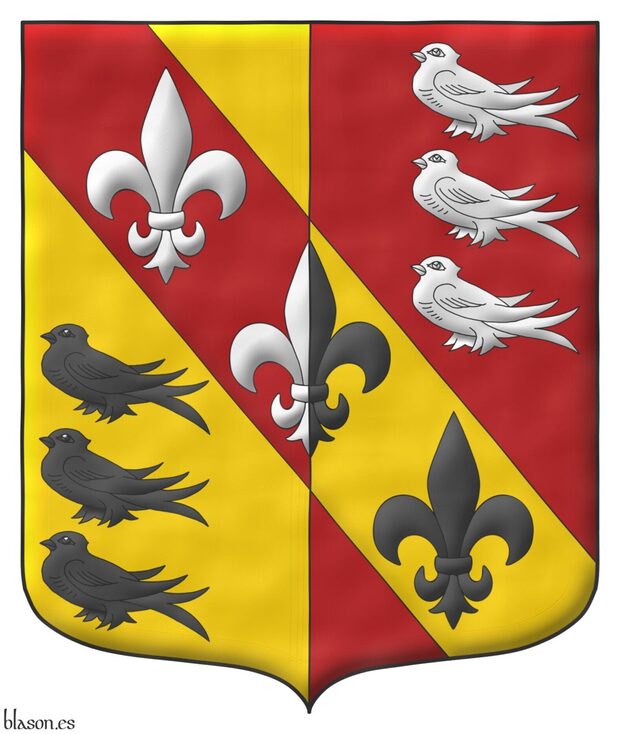
Party per pale Or and Gules, on a bend counterchanged three fleur de lis palewise counterchanged Argent and Sable between six martlets, 3 and 3 in pale, counterchanged Sable and Argent.
Escudo partido: 1o de oro, en la diestra de la punta tres marletas en palo de sable; 2o de gules, en la siniestra del jefe tres marletas en palo de plata; brochante sobre el todo una banda del uno al otro cargada de tres flores de lis puestas en palo, la primera de plata, la segunda partida de plata y sable y la tercera de sable.
Arms devised by me, illuminated with lights and shadows, contoured in Sable, with an ogee external shape and with a watercolor finishing.
Coat of arms of Matthew Nelson designed by him and me and emblazoned by me. Alternative blazon: «Party per pale: 1 Or, in the dexter of the base three martlets in pale Sable; 2 Gules, in the sinister of the chief three martlets in pale Argent; overall a bend counterchanged charged with three fleurs de lis palewise, the first Argent, the second per pale Argent and Sable, and the third Sable».
Design rationale
This design combines elements and tinctures from the arms of his lineages: Luttrell, Anglo-Irish, and Nelson from Ireland, along with personal details. The bend, martlets, Or, and Sable are from Luttrell. The fleurs de lis Argent, Sable, and per pale Argent and Sable are from Nelson. As personal elements, the layout includes the letter N from his surname, and the color Gules.
Blazon keywords: Or, Sable, Gules, Argent, One, Three, Party per pale, Dexter, Base, Martlet, In pale, Sinister, Chief, Overall, Bend, Counterchanged, Counterchanged (side-by-side), Charged, Fleur de lis and Palewise.
Style keywords: Outlined in sable, Illuminated, Ogee and Watercolor.
Classification: Personal, Created, Design rationale, Boa and Coat of arms.
Bearer: Nelson, Matthew.


Crest and mantling of Matthew Nelson
Party per pale Or and Gules, on a bend counterchanged three fleur de lis palewise counterchanged Argent and Sable between six martlets, 3 and 3 in pale, counterchanged Sable and Argent. Crest: Upon a helm with a wreath Or and Gules, a demi-horse Sable. Mantling: Gules doubled Or.
Arms devised by me, illuminated with lights and shadows, outlined in Sable, with an ogee external shape and with a watercolor finishing.
Coat of arms of Matthew Nelson designed by him and me and emblazoned by me. Alternative blazon: «Party per pale: 1 Or, in the dexter of the base three martlets in pale Sable; 2 Gules, in the sinister of the chief three martlets in pale Argent; overall a bend counterchanged charged with three fleurs de lis palewise, the first Argent, the second per pale Argent and Sable, and the third Sable. Crest: Upon a helm with a wreath Or and Gules, a demi-horse Sable. Mantling: Gules doubled Or».
Blazon keywords: Or, Sable, Gules, Argent, One, Three, Party per pale, Dexter, Base, Martlet, In pale, Sinister, Chief, Overall, Bend, Counterchanged, Counterchanged (side-by-side), Charged, Fleur de lis, Palewise, Crest and mantling, Crest, Upon (wreath), Helm, Wreath, Demi, Horse, Mantling and Doubled.
Style keywords: Outlined in sable, Illuminated, Ogee and Watercolor.
Classification: Personal, Created, Boa and Coat of arms.
Bearer: Nelson, Matthew.


España Herranz, Angel
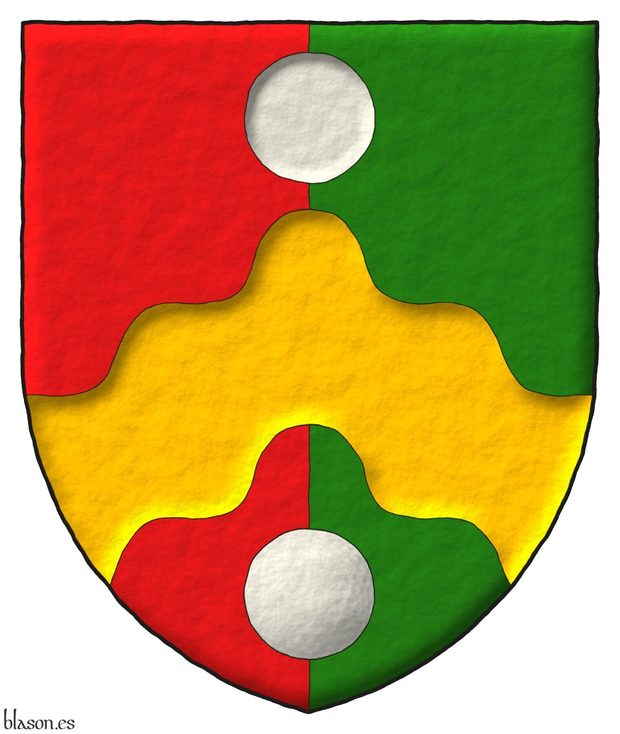
Party per pale Gules and Vert, overall a chevron wavy Or between two plates in pale.
Escudo partido de gules y sinople, brochante sobre el todo un cabrio ondado de oro acompañado de dos bezantes en palo de plata.
Coat of arms designed by me, highlighted with lights and shadows, outlined in Sable, and with a freehand finishing.
Coat of arms of Angel España Herranz designed by him and me, and emblazoned by me.
Design rationale
The first quarter of Gules with the dexter of the chevron Or are España, his surname. In the second quarter, the Vert is the green, the wavy chevron Or a bunker, and the two plates represent a ball and a hole of golf, his passion.
Blazon keywords: Gules, Vert, Or, Argent, One, Two, Party per pale, Overall, Chevron, Wavy, Between, Plate and In pale.
Style keywords: Outlined in sable, Illuminated and Freehand.
Classification: Personal, Created, Boa and Coat of arms.
Bearer: España Herranz, Angel.


![Ver [Piferrer, F.; 1858] en referencias bibliográficas. Libro abierto, hojas de plata, filo de oro, guardas de gules, tapas de sable.](../css/Libro.Bibliografia.png)
Piferrer, F.; 1858
Francisco Piferrer, «Treatise on Heraldry and Blazonry», illustrated by José Asensio y Torres, 292 pages, revised, corrected, and expanded by the same author, printed by Antonio Espinosa, Madrid, 1858.
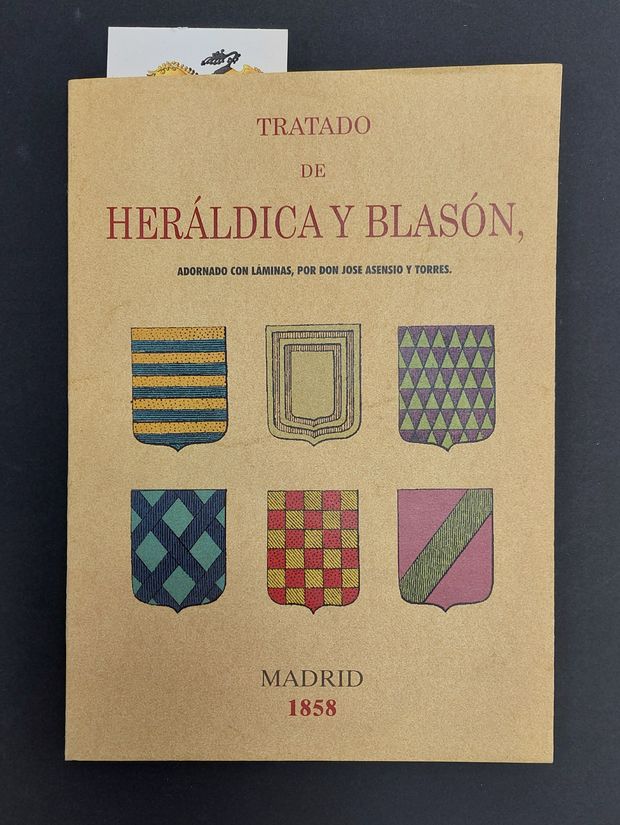
Francisco Piferrer was a 19th-century Spanish writer and historian, specialized in heraldry and genealogy. He was a prominent figure in the dissemination of nobiliary and heraldic history in Spain. Among his most notable works is this «Treatise on Heraldry and Blazon» published in 1858, a fundamental work that is still considered a reference in the field today. His work is valued for its meticulous documentation and for laying the foundations for other heraldic studies in Spain.
Bibliographical reference of century XIX.
Classification: De bibliotheca, Castilian language and In black and white.
The author is Piferrer, Francisco.
External links:
- University of Granada, book record.
- University of Granada, original scanned PDF, under a Creative Commons Attribution-NonCommercial-NoDerivs 3.0 License.
Internal resources: PiferrerF1858.22.TratadoHeraldicaBlason.UGr.B-014-074_2.pdf is the 1858 edition scanned into a digital PDF format by the University of Granada and A facsimile edition as a physical book on paper.

Continue with: Herndon, family of Paul and Kari.
-
Language
-
Categories of heraldry
-
Divisions of the field
- Without divisions
- Party per pale
- Party per fess
- Party per bend
- Party per bend sinister
- Tierce
- Tierce sinister
- Tierced per pale
- Tierced per fess
- Tierced per bend
- Tierced pallwise inverted
- Quarterly
- Quarterly per saltire
- Gyronny
- Party per fess, the chief per pale
- Party per pale, the sinister per fess
- Party per fess, the base per pale
- Party per pale, the dexter per fess
- Chapé
- Chaussé
- Embrassé
- Contre-embrassé
- Party per chevron
- Enté
- Enté en point
- Flanched
-
Metals
-
Colours
-
Furs
-
Other tinctures
-
Ordinaries and sub-ordinaries
-
Diminutives of the ordinaries
-
Geometric charges
-
Composite ordinaries
-
Inanimate charges from Nature
Atom, Crescent, Diamond, Emerald, Estoile, Increscent, Lightning flash, Moon, Mount, Mullet, Mullet of four points, Orbital, Plough of Ursa Major, Rainbow, Ray of the sun, River, Sea, Snowflake, Sun, Sun in splendour, Sun of May, Trimount, Water and Wave.
-
Vegetal charges from Nature
Acorn, Apple, Apple tree, Ash, Bluebonnet, Camellia, Chrysanthemum, Cinquefoil, Cornflower, Dogwood flower, Double rose, Elm, Fleur de lis, Flower, Gourd, Holm oak, Hop cone, Kapok tree, Laurel, Lily, Linden, Lotus flower, Madonna lily, Mexican cedar tree, Oak, Olive tree, Palm tree, Plantain plant, Pomegranate, Poplar leaf, Rose, Shamrock, Sunflower, Thistle, Tree, Tulip, Vine and Wheat.
-
Animal charges from Nature
Badger, Bald eagle, Barbel, Barn owl, Bear, Beaver, Beetle, Bighorn sheep, Blackbird, Boar, Brach hound, Bull, Doe, Dog, Dolphin, Dove, Eagle, Elephant, Falcon, Female figure, Fish, Flame, Fly, Fox, Frog, Goat, Goldfinch, Goose, Heron, Horse, Hummingbird, Jaguar, Lark, Leopard, Lion, Lion passant, Lion rampant guardant, Lioness, Lynx, Male figure, Martlet, Merino ram, Owl, Panther, Parrot, Peacock, Pelican, Pelican in her piety, Puffin, Quetzal, Raven, Roe deer, Rooster, Savage, Seagull, Serpent, She-wolf, Stag, Starling, Talbot, Tyger, Vulture, Warren hound and Wolf.
-
Parts of natural charges
Arm, Beak, Branch, Caboshed, Chest, Claw, Covert, Dorsal fin, Eagle claw, Ermine spot, Escallop, Feather, Foot (palmiped), Foreleg, Forepaw, Hand, Head, Heart, Hoof, Leaf, Neck, Ostrich feather, Palm frond, Paw, Roe deers' attires, Shoulder, Sprig, Stags' attires, Stem, Swallow-tail, Tail, Tail addorsed, Tail fin, Talon, Tooth, Trunk, Trunk (elephant), Two hands clasped, Two wings in vol, Udder, Wheat spike, Wing and Wrist.
-
Artificial charges
Ace of spades, Anchor, Anvil, Arch, Arm vambraced, Armillary sphere, Arrow, Axe, Bell, Bell tower, Beret, Bonfire, Book, Bookmark, Bow, Branding iron, Bridge, Broken, Buckle, Cannon, Cannon dismounted, Cannon port, Canopy roof, Carbuncle, Castle, Celtic Trinity knot, Chain, Chess rooks, Church, Clarion, Clay pot, Closed book, Club, Column, Comb, Compass rose, Conductor's baton, Cord, Covered cup, Crozier, Crucible, Cuffed, Cup, Cyclamor, Dagger, Double vajra, Drum, Ecclesiastical cap, Fanon, Federschwert, Fleam, Four crescents joined millsailwise, Galician granary, Garb, Gauntlet, Geometric solid, Grenade, Halberd, Hammer, Harp, Host, Hourglass, Key, Key ward, Knight, Knot, Lantern, Letter, Line, Loincloth, Menorah, Millrind, Millstone, Millwheel, Monstrance, Mortar, Mullet of six points pierced, Nail, Non-classic artifact, Norman ship, Number, Oar, Oil lamp, Open book, Page, Pair of scales, Parchment, Pestle, Piano, Pilgrim's staff, Plough share, Polish winged hussar, Port, Portcullis, Potent, Quill, Ribbon, Rosette of acanthus leaves, Sabre, Sackbut, Sail, Scroll, Scythe, Sheaf of tobacco, Ship, Skirt, Spear, Spear's head, Stairway, Star of David, Step, Sword, Symbol, Tetrahedron, Torch, Tower, Trident, Trumpet, Turret, Two-handed sword, Wagon-wheel, Water-bouget, Wheel, Winnowing fan and With a turret.
-
Immaterial charges
Angel, Archangel, Basilisk, Dragon, Dragon's head, Garuda, Golden fleece, Griffin, Heart enflamed, Justice, Mermaid, Our Lady of Mercy, Ouroboros, Paschal lamb, Pegasus, Phoenix, Sacred Heart of Jesus, Saint George, Sea-griffin, Trinity, Triton, Unicorn, Winged hand and Wyvern.
-
External elements
-
Heraldic creations
-
References
-
Formats
-
Keywords on this page
Between, Watercolor, Aspe, Julio Hector, Azure, Point downwards, Bend, Flag, Bibliography, Boa, Overall, Wreath, Base, Charged, Upon (wreath), Crest, Ogee, Ogee Triple-Pointed, Regardant, Paschal lamb, Created, Cross, Counterchanged, Counterchanged (side-by-side), Outlined in sable, Dexter, Two, In black and white, In fess, In pale, Coat of arms, Sword, Fleur de lis, Personal, Gules, Haurient, Illuminated, Mantling, Or, Party per pale, Fish, Argent, Bend sinisterwise, Debruised, Sable, Crest and mantling, Three, Trumpet, One and Helm.

